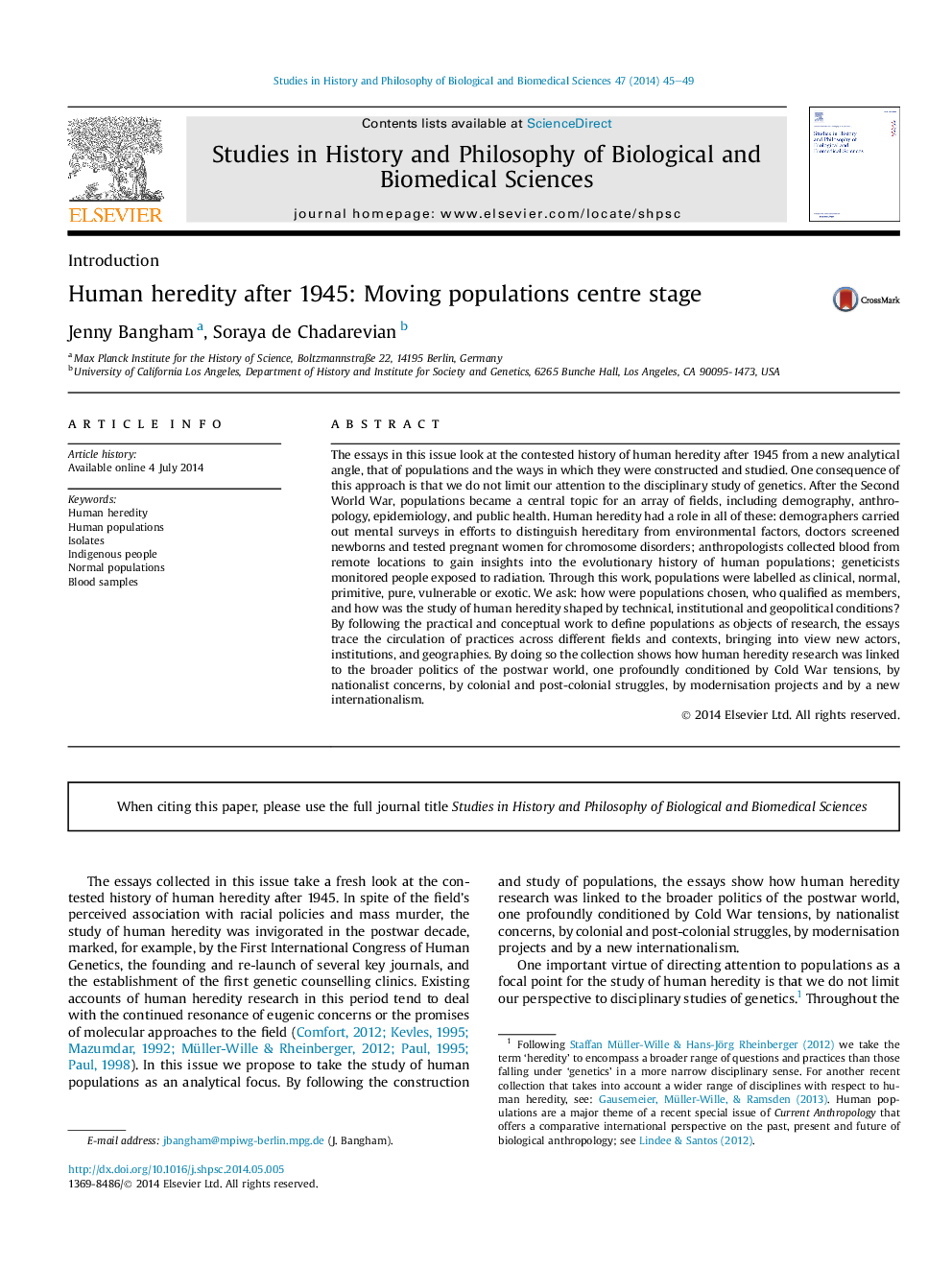| کد مقاله | کد نشریه | سال انتشار | مقاله انگلیسی | نسخه تمام متن |
|---|---|---|---|---|
| 7552612 | 1490520 | 2014 | 5 صفحه PDF | دانلود رایگان |
عنوان انگلیسی مقاله ISI
Human heredity after 1945: Moving populations centre stage
ترجمه فارسی عنوان
وراثت انسانی بعد از سال 1945: حرکت مرکز جمعیت
دانلود مقاله + سفارش ترجمه
دانلود مقاله ISI انگلیسی
رایگان برای ایرانیان
کلمات کلیدی
وراثت انسان، جمعیت انسانی، جداسازی مردم بومی، جمعیت عادی، نمونه های خون،
ترجمه چکیده
مقالاتی که در این شماره به تاریخ بحث و جدل انسانی بشر پس از سال 1945 از یک زاویه تحلیلی جدید، جمعیت ها و راه هایی که در آن ساخته شده و مورد مطالعه قرار گرفته اند، نگاه می کنند. یک نتیجه از این رویکرد این است که توجه ما به مطالعه انضباطی ژنتیک را محدود نمی کند. پس از جنگ جهانی دوم، جمعیت ها به عنوان یک موضوع اصلی برای مجموعه ای از زمینه ها، از جمله جمعیت شناسی، انسان شناسی، اپیدمیولوژی، و بهداشت عمومی تبدیل شد. وراثت انسان در تمامی این موارد نقش داشته است: جمعیت شناسان تحقیقات ذهنی را در تلاش برای تشخیص ارثی از عوامل محیطی انجام دادند، پزشکان نوزادان را آزمایش کردند و زنان باردار را برای اختلالات کروموزوم آزمایش کرد؛ انسان شناسان خون از مکان های دور را جمع آوری می کنند تا بینش های تاریخ تکاملی جمعیت بشری را به دست آورند؛ ژنتیک افراد مبتلا به اشعه را کنترل می کند. از طریق این کار، جمعیت ها به عنوان بالینی، طبیعی، ابتدایی، خالص، آسیب پذیر یا عجیب و غریب نامگذاری شده اند. ما می پرسیم: چگونه جمعیت ها انتخاب شدند، که به عنوان اعضای واجد شرایط شناخته شده بودند، و چگونه مطالعه وراثت انسان بر اساس شرایط فنی، نهادی و ژئوپولیتیک شکل گرفت؟ با پیروی از کار عملی و مفهومی برای تعریف جمعیت به عنوان اشیاء تحقیق، مقالات در مورد شیوه های مختلف در حوزه ها و زمینه های مختلف، به نمایش بازیگران، نهادها و جغرافیای جدید نگاه می کنند. با انجام این کار، این مجموعه نشان می دهد که چگونه پژوهش های ارثی انسانی با سیاست های گسترده تر از جهان پس از جنگ همراه بود، که عمیقا تحت تأثیر تنش های جنگ سرد، نگرانی های ناسیونالیستی، مبارزات استعماری و پس از استعمار، با پروژه های مدرنیزاسیون و بین المللی جدید بود.
موضوعات مرتبط
علوم زیستی و بیوفناوری
علوم کشاورزی و بیولوژیک
علوم کشاورزی و بیولوژیک (عمومی)
چکیده انگلیسی
The essays in this issue look at the contested history of human heredity after 1945 from a new analytical angle, that of populations and the ways in which they were constructed and studied. One consequence of this approach is that we do not limit our attention to the disciplinary study of genetics. After the Second World War, populations became a central topic for an array of fields, including demography, anthropology, epidemiology, and public health. Human heredity had a role in all of these: demographers carried out mental surveys in efforts to distinguish hereditary from environmental factors, doctors screened newborns and tested pregnant women for chromosome disorders; anthropologists collected blood from remote locations to gain insights into the evolutionary history of human populations; geneticists monitored people exposed to radiation. Through this work, populations were labelled as clinical, normal, primitive, pure, vulnerable or exotic. We ask: how were populations chosen, who qualified as members, and how was the study of human heredity shaped by technical, institutional and geopolitical conditions? By following the practical and conceptual work to define populations as objects of research, the essays trace the circulation of practices across different fields and contexts, bringing into view new actors, institutions, and geographies. By doing so the collection shows how human heredity research was linked to the broader politics of the postwar world, one profoundly conditioned by Cold War tensions, by nationalist concerns, by colonial and post-colonial struggles, by modernisation projects and by a new internationalism.
ناشر
Database: Elsevier - ScienceDirect (ساینس دایرکت)
Journal: Studies in History and Philosophy of Science Part C: Studies in History and Philosophy of Biological and Biomedical Sciences - Volume 47, Part A, September 2014, Pages 45-49
Journal: Studies in History and Philosophy of Science Part C: Studies in History and Philosophy of Biological and Biomedical Sciences - Volume 47, Part A, September 2014, Pages 45-49
نویسندگان
Jenny Bangham, Soraya de Chadarevian,
